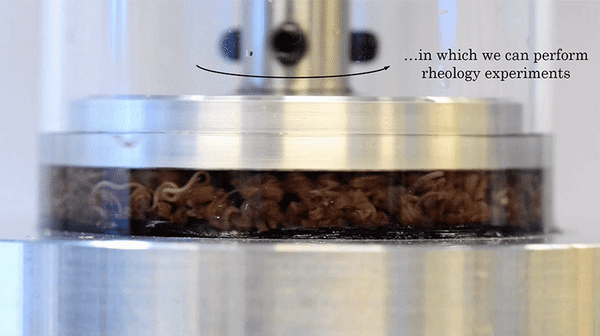Why do scientists get worms to drink and make them spin like this?
In the rotating compartment there is a combination of intoxicating worms with numbers up to hundreds of children; The idea that just alcohol is enough for the mind to spin, turns out to be able to take advantage of experimental equipment to reel even more fiercely.
At first glance, this experiment may seem a little . weird, but its purpose is extremely lofty. Scientists want to know more about active polymers. 'polymers' is a term for a compound with a large molecular mass and in its structure repeats many basic links, polymers exist both in nature (such as DNA chains) and Can also be artificial products.

The solution contains spinning worms in the rheometer device.
Physicists have suggested that the worm of the genus Tubifex (Tubifex tubifex, which is a species of worm, often living in lakes and rivers on different continents) could be the main subject of active polymer research. , could even become the starting point for a whole new field of research called living polymers.
' Active polymers are an interesting class of active systems, because they exist in many biological systems of varying lengths, ' said Antoine Deblais, a scientist from the University of Amsterdam and also a in many study authors told Gizmodo. ' At the nanoscale and microscopic levels, biology provides many examples of flexible active structures, from actin fibers, microtubules to whip hairs of sperm, algae, bacteria, and then to numerous planktonic organisms as well. By using these basic systems (such as active polymers), we will better understand the active fibers in general '.
Currently, science is not available for experimental systems for active polymer research, making it difficult to observe their movement. This 'drunken worm rotation' experiment will involve worms released in water, simulating active polymers - a system of individual individuals that can move in specific ways. Besides being easy to observe, both worms and alcohol are easy to find.

Worm activity in water and in water with 5% alcohol content.
The team observed a large number of worms in a rheometer device (a tool used to measure the movement of a fluid or mucus when the force is applied). They filled the tubifex worms into the cavity, observing their movements under different conditions; The results showed that the worm worked slowly when the temperature dropped or when the solution was 5% alcohol.
When the temperature is low enough or the alcohol content is high enough, the worm stops stirring, the flow of solution appears 'shear thinning', roughly translated as 'absolute dilution', where the rotation increases, the fibers in The solution combination (ie the worms in this test) will move in the same direction, allowing the fluid to flow more easily. However, when removing the alcohol, the absolute dilution factor decreases as the worms begin to move in random directions.
Physicists plan to replicate this experiment on regular polymer chains, observing what happens when accidental movements occur.
The research was published in Physical Review Letters.
You should read it
- Alcohol poisoning: symptoms and treatment
- Pests can eat plastic, savior of man-made plastic waste
- Tips to help you get rid of alcohol quickly and effectively
- New online tools can help treat alcohol use disorders
- What happens when you stop drinking for about 21 days?
- 4 effects of alcohol on the brain that many people do not know
 CO2 capture filter: A groundbreaking idea for the post-carbon industry
CO2 capture filter: A groundbreaking idea for the post-carbon industry China invented something that could replace jet engines
China invented something that could replace jet engines Discover the black hole closest to Earth, located in the star system that we can see with the naked eye
Discover the black hole closest to Earth, located in the star system that we can see with the naked eye This is an AI system that can turn people into animals and vice versa
This is an AI system that can turn people into animals and vice versa Impressive image: ISS International Space Station flies over the Sun.
Impressive image: ISS International Space Station flies over the Sun. Why are cartridges usually made of copper and not steel, lead or aluminum?
Why are cartridges usually made of copper and not steel, lead or aluminum?